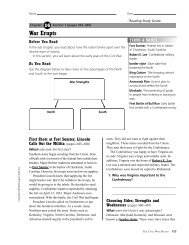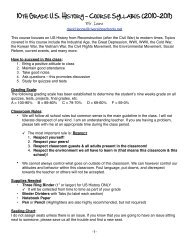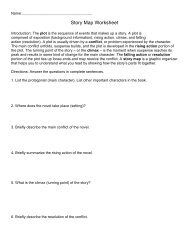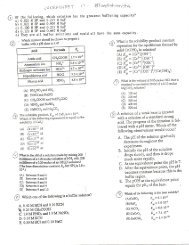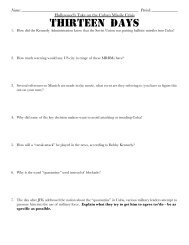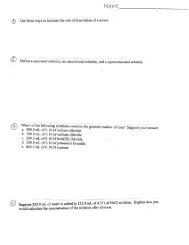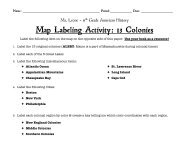Chapter 16 Text
Chapter 16 Text
Chapter 16 Text
You also want an ePaper? Increase the reach of your titles
YUMPU automatically turns print PDFs into web optimized ePapers that Google loves.
<strong>16</strong>.11 Lewis Acids and Bases 651<br />
Salt:<br />
Indicator:<br />
NaNO3<br />
Bromthymol<br />
blue<br />
Ca(N03)2<br />
Bromthymol<br />
blue<br />
Zn(N03)2<br />
Methyl<br />
red<br />
A1(N03)3<br />
Methyl<br />
orange<br />
Estimated pH:<br />
6.9<br />
5.5<br />
3.5<br />
A Figure <strong>16</strong>.<strong>16</strong> The pH values of 1.0 M solutions of a series of nitrate salts, as estimated<br />
using acid-base indicators. From left to right, NaNC>3, Ca(NO3)2, Zn(NO3)2, and AI(NO3)3.<br />
(a) Explain why H3FO3 is diprotic and not triprotic. (b) A 25.0-mL sample of a solution<br />
of H3PO3 is titrated with 0.102 M NaOH. It requires 23.3 mL of NaOH to neutralize<br />
both acidic protons. What is the molarity of the H3PO3 solution? (c) This solution<br />
has a pH of 1.59. Calculate the percent ionization and Xnl for H3PO3, assuming that<br />
Kai » Ka2 • (d) How does the osmotic pressure of a 0.050 M solution of HC1 compare<br />
with that of a 0.050 M solution of H3PO3? Explain.<br />
Solution The problem asks us to explain why there are only two ionizable protons in<br />
the H3PO3 molecule. Further, we are asked to calculate the molarity of a solution of<br />
H3PO3, given titration-experiment data. We then need to calculate the percent ionization<br />
of the H3PO3 solution in part (b). Finally, we are asked to compare the osmotic<br />
pressure of a 0.050 M solution of H3PO3 with that of an HC1 solution of the same<br />
concentration.<br />
We will use what we have learned about molecular structure and its impact on<br />
acidic behavior to answer part (a). We will then use stoichiometryfand the relationship<br />
between pH and [H+] to answer parts (b) and (c). Finally, we will consider acid<br />
strength in order to compare the colligative properties of the two solutions in part (d).<br />
(a) Acids have polar H — X bonds. From Figure 8.6 we see that the1 electronegativity<br />
of H is 2.1 and that of P is also 2.1. Because the two elements have the same electronegativity,<br />
the H — P bond is nonpolar. ^^ {Section 8.4) Thus, this H cannot be<br />
acidic. The other two H atoms, however, are bonded to O, which has an electronegativity<br />
of 3.5. The H — O bonds are therefore polar, with H having a partial positive<br />
charge. These two H atoms are consequently acidic.<br />
(b) The chemical equation for the neutralization reaction is<br />
H3PO3(flq) + 2NaOH(flif)-*Na2HP03(flq) + H2O(/)<br />
From the definition of molarity, M = mol/L, we see that moles = M x L. ^°<br />
(Section 4.6) Thus, the number of moles of NaOH added to the solution is<br />
(0.0233 L) (0.102 mol/L) - 2.377 X 10~3 mol NaOH. The balanced equation indicates<br />
that 2 mol of NaOH is consumed for each mole of H3PO3 . Thus, the number of moles<br />
of H3PO3 in the sample is<br />
(2.377 X 10"3 mol NaOH) /lmolH3PO3A - - , K ' „<br />
Y 2 mol NaOH J<br />
,<br />
= 1.189 X 10-3molH3PO3<br />
The concentration of the H3PO3 solution therefore equals (1.189 X 10"3 mol)/(0.0250 J)<br />
= 0.0475 M.<br />
(c) From the pH of the solution, 1.59, we can calculate [H+] at equilibrium.<br />
[H+] - antilog(-1.59) = 10~L59 = 0.026 M (2 significant figures)



